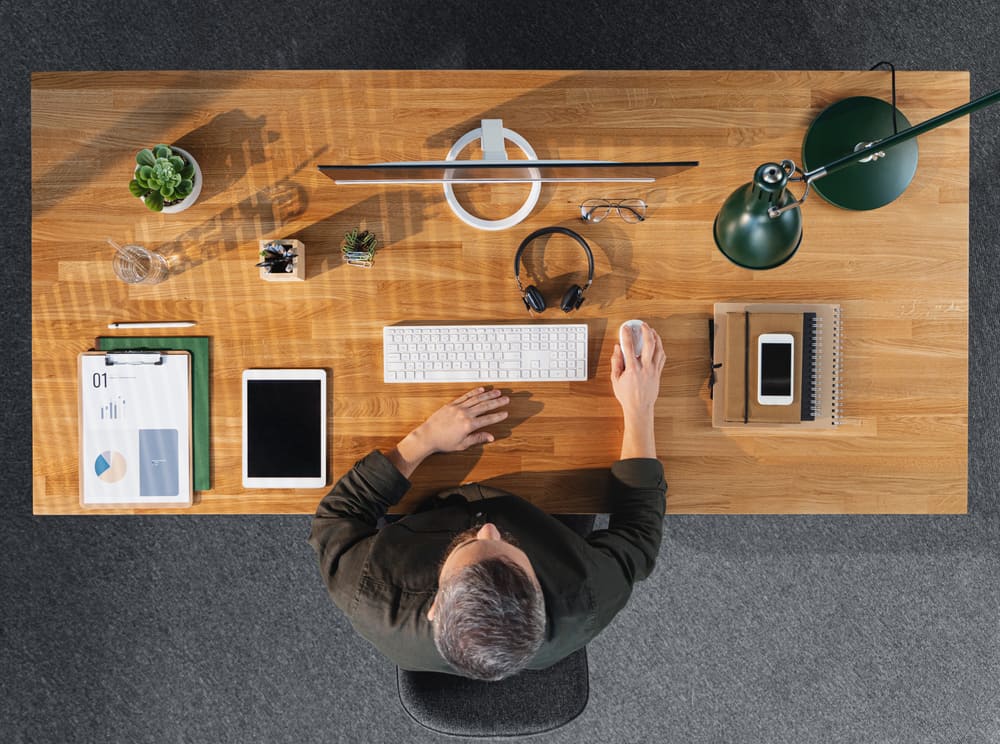
Solid State Drives or SSDs have become so popular with PC owners due to their outstanding performance, and they’re gradually replacing Hard Disk Drives or HDDs.
As of now, however, most PC owners choose to have both SSDs and HDDs in their system.
That’s because SSDs come at a much higher price, and most people can only afford to buy a low-capacity one just to store their OS and applications on it.
They keep their files on a high-capacity HDD.
This method works great for boosting the overall performance of a computer, but only if the SSD doesn’t fill up with extra files.
If yours has, read on to learn how to move the files from your SSD to your HDD.
How To Move Files From SSD To HDD?

There are multiple methods you can use to move files from SSD to HDD.
You can use either the Windows built-in function or one of the many software made for such occasions.
1. Cut And Paste

The first method that must have come into your mind is using the Windows built-in cut and paste or copy and paste feature.
This function will work just fine for transferring small numbers of simple files from an SSD to an HDD, including videos, photos, and documents.
It would be a simple job if all the files were in the same directory, but they’re usually not, and that’s what makes this method flawed.
Going back and forth between the SSD and HDD drives to cut and paste files is time-consuming, and it can get annoying quickly.
If you have multiple file paths you want to move, it might be best to wait for the following methods.
Also, you can’t use this feature for moving apps and games because they won’t normally work after moving.
You’ll find out how to transfer apps and games in the following sections of this article.
Moreover, you may face various permission issues in the process, but it’s nothing you can’t solve.
If you decided to cut and paste files and you faced a “Destination Folder Access Denied” error, here’s how to get around it:
- Type “local group policy editor” in the Windows search bar and open the app.
- Navigate your way through this path: Computer Configuration > Windows Settings > Security Settings > Local Policies > Security Options.
- Once you’ve clicked on Security Options, search in the list for the following directories:
- User Account Control: User Account Control for the Built-in Administrator.
- User Account Control: Run all administrators in Admin Approval Mode.
- Right-click on both, choose Properties, and Enable them one after the other.
- Next, you’ll have to right-click on the This PC icon located on your desktop.
- Select Manage from the drop-down menu.
- Once the Computer Management window opens up, go to System Tools > Local Users and Groups > Users.
- Right-click on Administrator and select Properties.
- Uncheck the box next to “Account is disabled” and hit the OK button.
- Restart your PC for the changes to take place.
2. MiniTool Partition Wizard

MiniTool Partition Wizard is a helpful app for arranging the space on disks and drives.
It has many capabilities, but what you need now is the copy function.
It’s much more convenient than the Windows copy function for moving multiple files.
Here’s how to use it:
- Download, install, and launch the MiniTool Partition Wizard app.
- You must see all your disk drives in the main interface, including the SSD and HDD with all their partitions.
- Right-click on a partition of the SSD you’d like to move and select Copy.
- Choose the HDD as the target location for pasting the partition and click on Next.
- Preview the new partition and hit the Apply button if you approve.
3. Use AOMEI Backupper

The AOMEI Backupper Standard is a program with multiple useful features, one of which is the basic sync features that can help you transfer files from the SSD to the HDD.
Follow along the steps to complete the process:
- Once you’ve installed the program, launch it.
- Click on Sync from the menu bar and then select Basic Sync.
- Click on the Add to folder box and add the folders you’d like to move.
- Now select the HDD as the path you’d like to transfer the folders to.
- If you’d like the sync to become an automatic process, click on Schedule and choose between the Daily, Weekly, or Monthly options.
- By clicking on Options, you can enable email notification for the syncing process or write a note.
- Once you’re done customizing, click on the Start Sync button.
If you upgrade the app to AOMEI Backupper Professional, you’ll get additional features concerning the syncing feature, including the following:
- Mirror Sync: Mirror syncing will keep the files in the source and destination the same.
- Two-Way Sync: If you create any changes in the source directory, the app will do the same in the destination and vice versa.
- Real-Time Sync: Real-Time Sync will sync the changed files from the source to the destination in real-time.
- Event Triggers: You’ll be able to specify sync tasks at specific events like system shutdown or start-up.
4. Use The EaseUS Tool

The EaseUS Todo PCTrans software offers two simple methods for transferring files from an SSD to an HDD.
A. File Migration Feature
The file migration feature is a direct way to move small and large files between two drives, the SSD or the HDD.
- Download and launch the EaseUS Todo PCTrans and click on large file cleanup from the menu.
- Select the SSD where your files are stored as the partition you’d like to scan.
- Once the scan is over, you’ll see all the files larger than 20MB. Select the ones you’d like to transfer.
- Define the HDD as the target path.
- Hit the Move button, confirm the action, and click on the Move button again.
B. Backup And Restore Feature
The EaseUS software also allows you to create a backup from the SSD files you’d like to move and then restore them in the HDD.
- Select the Backup & Restore option from the menu tab and hit the Start button.
- Click on the Data Backup option at the top and click Next.
- Now you either need to confirm the default settings for the file name and path or customize them.
- Next, you should select the items you want to back up. Deselect the Application and Accounts sections.
- Select the Files section and choose Edit.
- Choose all the files you’d like to move, and then click Finish.
- Click on the Backup button and wait for the process to complete.
- Now, repeat the first step, but this time, select the Data Restore option from the top and hit Next.
- Now choose the backup file you’ve created that appears on the screen or navigate to its path and select it.
- Once you hit the Restore button, the app will take you back to the Files section, from where you should select the Edit option.
- Now you must see the list of files you’ve backed up. Click on the pencil icon at the top right corner and choose the HDD as the location to save the backup file.
- Click on the Finish button and then the Restore button.
- After the process is complete, open the SSD drive and delete all the files you’ve transferred to the HDD.
How To Move Apps And Games From SSD To HDD

If you treat your apps and games the same as simple files when transferring them from one driver to another, you won’t be able to open and run them afterward.
You’ll have to reinstall them all, which may take a lot of time and effort.
Therefore, it’s best to start on the right foot and do the easy thing from the beginning:
- First, you should move the Program Files folder from the SSD to the HDD with the cut and paste function. For example, you’ll be transferring the “C: \Program Files” to “D: \Program Files.”
- Then, type “Command Prompt” in the Windows search box, right-click the app and choose Run as administrator.
- In the window that pops open, type in the following commands in order:
- mklink /D “Program Files”
- “D: Program Files”
That is a symbolic link command line that creates a shortcut to program files attached to the desktop.
When Windows or any app tries to access the folder, the link will redirect it to the new location.
This means you’ll be able to use “C:\Program Files” as the default install path, but the installed files will be stored in “D:\Program Files.”
If you’d like to transfer a number of your chosen apps from the SSD to the HDD, you’ll have to use third-party software like the EaseUS Todo PCTrans.
- Open the program and select the App Migration section.
- Click on Start and then choose the apps you’d like to transfer.
- Click on Browse and select the HDD as your target path.
- Hit the Transfer button, and once it’s over the OK button.
- Restart the PC for the changes to take place.
How To Move Any Of The User Files From SSD To HDD

If your user files, including your documents, downloaded files, photos, etc., keep appearing in the SSD, Windows has automatically selected the SSD as the default storage.
You don’t have to keep moving the files every time the SSD gets full.
You can just change the location of the default user files to the HDD and have Windows store them there automatically.
- Type “run” in the Windows search bar and open the app.
- Type “%userprofile%” in the box and hit enter to access the user folder.
- Right-click on any of the folders you’d like to move, like Downloads.
- Select Properties and navigate to the Location tab.
- Change the location of the file from the C:\ driver to the D:\ drive. For example, replace C:\Users\YourName\Downloads to D:\Users\YourName\Download.
- If you’ve changed the names of the drives before, choose the dedicated HDD drive as the destination.
- Hit the Apply button and then OK.
What Is The Difference Between SSDs And HDDs?

The main difference between HDDs and SSDs is in how fast they can access data.
Hard drives have a spinning disk-shaped platter and a mechanical arm that moves on the platter to read and write data.
Since all of its pieces are mechanical, an HDD is the slowest and most fragile computer component.
SSDs store the data on flash memories.
They consist of individual memory cells that store bits of data that are instantly accessible by the system.
SSDs are much more efficient at data access time, which makes them faster than HDDs.
However, as mentioned earlier, they come at higher prices compared to HDDs.
SSDs are smaller, and they’re more durable because of their shock-resistant features.
As opposed to HDDs, they don’t make any noise or generate any heat.
Why Should You Transfer Files From SSD To HDD?

Considering the performance and price of SSDs and HDDs, you might own both components in your PC.
If you’ve invested in a small-capacity SDD like 125 GB, 250 GB, or 500 GB, as many people do, facing storage issues is expected.
The best way to handle the situation without jeopardizing your PC’s performance is by emptying the SSD from unnecessary files.
If you only store your OS, apps, and games on the SSD, you’ll experience much faster start-up times, smoother gameplay, and faster workloads.
You’ll have to store other data like documents, pictures, and videos on your HDD to prevent your computer’s performance from degrading.
Frequently Asked Question

1. What Is Better: HDD Or SSD?
SSDs are a new generation of more enhanced storage devices.
They’re faster than HDDs, and they use less power than HDDs.
They don’t generate heat or noise, either.
Their only downside is their higher price range than HDDs, which is reasonable considering their superior performance.
2. Can I Transfer Windows From An HDD To An SSD?
Yes, you can transfer Windows from an HDD to an SSD in the same system.
You’ll have to install the SSD alongside the older HDD.
Then, you’ll need help from third-party tools to move the OS from one to another.
EaseUs Partition Master is a capable software, and here’s how you move Windows with it:
- Open up the app and select Migrate OS from the menu.
- Choose the SSD as the destination disk and hit Next.
You can also use AOMEI Partition Assistant for transferring the OS efficiently:
- Launch the app and click on the Migrate OS to SSD option.
- Select the SSD as the destination location.
- If you have partitions on your SSD, you’ll have to check the box next to “I want to delete all partitions on disk 2 to migrate the system to the disk” and click on Next.
3. Can I Transfer My HDD To Another Computer?
Yes, you can transfer an HDD from one computer to another if their interfaces are compatible.
You can also place the HDD into an external drive enclosure and use it as a USB external hard drive.
NEXT: Computer Shuts Off And Won’t Turn Back On Until I Unplug It (Causes, Fixes)

























